[12 minute read]
“The objective of the blog is to highlight entertainment news be it in local television or music and performing arts happening in and around the country of Brunei Darussalam, and occasionally posting music news from around the globe.” – BruneiBuzz
“It is a portal which will provide free in-depth information and entertainment to the wired Bruneian and the general public. There will be varying of essential and useful content ranging from Islam to Tourism to Health and Sports and many more. The website’s main function is to be the creative platform for Brunei” – 1stopbrunei
“Join me on this projek, a projek to discover and rediscover this country they call the Abode of Peace, the Heart of Borneo, this place they call the Kingdom of Unexpected Treasures…through the stories of the People.” – ProjekBrunei
“The main aim of that website is to create entertainment, but now that there’s entertainment, people still don’t know about it and so then I created this website to increase awareness on all food and entertainment in Brunei.” – Brunei Entertainment
Prologue
What follows is an analysis of online culture in Brunei. It is written with the intent of reflecting on our current online practices and opening up a discussion about its direction.
What I have written also serves as an incomplete history of online culture in Brunei. It focuses on written blogs, leaving out many aspects such as web rings, mIRC and forums in order to understand platform websites. As I researched this essay I left out many things I wished to have kept in, there is plenty more that can be written about this subject.
These thoughts on online culture in Brunei emerged after the trip to Seattle on the invitation of Royal Brunei. It made me question the relation Open Brunei has with blogging and the role it could play within this space.
Introduction (back to Top)
1stopbrunei, The Amo Times, ASZBrunei, Brunei Buzz, Brunei fm, Brunei Foodies, BruneiShines, LoveFoodHateWaste (Brunei), Muzikaliti, Songket Alliance, Support Bruneian Artists, Open Brunei, ProjekBrunei, Ranoadidas, are described as: a place to highlight, a way to discover, a place to share, to raise awareness, a social blog, a portal, a platform.
These websites curate content. Online content may include poetry, drawings, comics, images, sounds, videos and so on. While some have write-ups with contextualizing information, others share content as it is. Websites such as LoveFoodHateWaste (Brunei) and Songket Alliance, also have original content for their website. But most of these websites fall to the latter, sharing content as it is, adding no more than three sentences or less of relevant information.
Platform websites have huge followings across social media. At the moment 1stopbrunei on Facebook has over 1,000 likes, BruneiTweet has close to 18,000 followers on Twitter and Brunei Foodies nearing 4,200 followers on Instagram. With 42,070 in total, Ranoadidas has around the same social media reach across Facebook, Twitter and Instagram as The Brunei Times with 37,350. However, Brunei fm on Facebook eclipses them all with them with 140,000 likes. As large as their social media reach, all have websites.
Local content, can be found on deviantART, Facebook, Pinterest, SoundCloud, Tumblr, Instagram, Twitter, WordPress and Blogger and to name a few. Blogging on platforms such as WordPress and Blogger are still seen as an established online presence, regardless of the length of time the website has been running. Websites are understood as official and legitimate. This sense of authority is based on having a logo and an explanation about what they are about, along with a unified look: altogether these elements serve to legitimize content.
While websites are perceived to be credible and on the pulse, by the time content reaches these websites, it has already been shared on Whatsapp, Facebook and Instagram commented on and analysed. Those who are interested in food, would have already found out about a promotion going on in their favourite restaurant through their Facebook page or on an advertisement and made plans with friends within a couple of minutes of viewing it.

Emergence of bloggers 2000s (back to Top)
Looking back at the rise of blogging in Brunei is helpful in framing the current emergence of platform websites. The mid-2000s saw the rise of blogging in the country which followed global trends.
In 2009, Lim Sheng Ming (LSM) wrote a four part piece on bloggers in Brunei for CNET Asia. He explained from his own perspective the rise of blogging in the country and refers to it as “The Bang of 2006″. He wrote: “I’m at a loss to explain exactly what changed in the years since 2001 but somehow Brunei Blogs came of age.”
The largest compilation of Brunei websites that is still accessible, Simpur Blogging Nation, is one of the most ambitious in terms of collating Bruneian content. The scale and exhaustiveness could never continue at the rate it did when it launched early 2007, the last blog to be added was in 2011. The blogs collated reflect prevalent trends during the period, moreover a need for content to be discovered and shared.
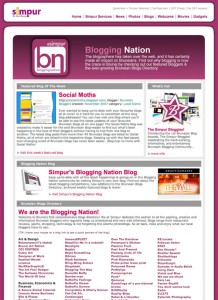
Blogs didn’t need to be searchable on search engines, such as Google or Yahoo due to features such as “pingback” or “trackback”. While blogrolls (below) helped in terms of showing a particular network of blogs, links were hardly easy to browse. Blogs listed in a blogroll aren’t distinguishable by name alone and most aren’t categorized by topic or theme. Simpur Blogging Nation helped to make sense of the sudden burst of blogs with content related to Brunei through categorization.
Reflecting a population ever more confident sharing their interests and a greater ability of building communities around them online, blogs covering specific topics emerged during this period: make-up, yoga, technology, Japanese culture, painting, fishing, photography and many more.
There was also a sense of personal expression, a willingness to open up. Zul-Fadly wrote on Soul Connection – Alter Ego in 2006, “[…] when I started this blog it was a place for me to put down my thoughts and perhaps elaborate on issues and matters from my perspective, but mostly it will be topics which I am familiar with.”
Gaining a readership during this period by sharing her personal thoughts was Maurina, with her blog Turquoise and Roses. It addressed key events in blogging: the transition of bloggers into print media, the use of blogging to highlight pressing issues and blogging to promote companies. These events continue to affect the relationship between blogging and the media, as well as, expectations of online content.
What drew readers was her honesty, humour and head-on stance addressing issues. Posts were written in a frenetic pace, not only were topics engaging with current issues but also rapidly engaged by readers. Topics included sex education, cleanliness in the capital, the Tutong community and call for the introduction of a Brunei Wiki.
The rapidity of engagement was partly down to access to the Internet becoming less limited by hardware and software. Easy to pick up tools on Blogger made posting simple and straightforward, even for a computer novice. Access to computers were becoming less of an issue and started to be within financial reach for most households. Even though Internet speeds in the country were crawling at 56kb/s or 128kb/s speeds, this did not stop people from posting content online.
Another indication of the rude health of blogging during this early period and the numerous styles and niche interest it sparked was Emmagoodegg’s list of bloggers written in 2006 on her blog (above). It highlighted bloggers who wrote about parenting, parking, photography, studying abroad, yoga to name a few subjects. In relation to print media available during the time, these topics and interests were far more relevant. English print media was limited in content; blogging provided an alternative.
It wasn’t until 2006 when The Brunei Times emerged as a broadsheet with the motto, “Fresh Ideas, New Option, Global Vision” that another English news outlet emerged. Their relationship with bloggers was strengthened through the short-lived Blog Speak column and their willingness to address blogging seriously. This relationship not only with bloggers but with the online community continues with their sharing of articles on social media and the ability to comment on website articles.
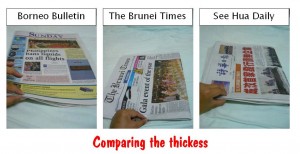
Emmagoodegg was also part of a group of bloggers in The Brunei Times column Blog Speak. LSM, wrote in part three of ‘Brunei Bloggers, a retrospective look’, “The Brunei Blogosphere was ecstatic: having been struck down by the hand of one newspaper they were now being lifted, venerated and even exonerated by the hand of another.” The other newspaper was the Borneo Bulletin, bloggers perceived the English daily to be less enthusiastic about blogging. In 2006 Borneo Bulletin carried the headline, “Bloggers beware libel lawsuits” (below) Katie-Ella noted on her blog that the article had lead to heated discussion among the blogging community.
Ranoadidas, Maurina, LSM and Emmagoodegg took turns to contribute a weekly column on a range of topics for Blog Speak. Presently only Emmagoodegg continues to contribute her writing to The Brunei Times, simultaneously posting them on her blog.
Only a few months into their inception The Brunei Times compiled a list of notable bloggers (above) which reflected the relationship it had with online culture and later that year profiled the writers of Blog Speak (below).
By the end of 2007, this period of almost boundless activity by bloggers and the seemingly endless array of blogs was waning. Post frequency per month for the blog by Jewelle Tan, Life in Lumut, Brunei (below) shows a gradual drop into 2008, as posts became less frequent. The Report: Brunei Darussalam 2011 attributed the decline to the failure to monetize. The report said, “[…] in more recent times, a number of these [blogs] have been abandoned or downgraded, which may indicate a realisation by many amateur bloggers that monetising output is no easy task.” Meanwhile, Maurina wrote, “I’m just wondering why everything is so quiet in the Brublogosphere lately? Even my blog stats have gone down. I hope none of us are losing our “zing”, if we actually had any in the first place.”
The Simpur Bloggies (right) masked this loss of momentum. The awards included five categories: ‘Personal’, ‘Local Scene’, ‘Speciality’, ‘Photo Blogs’ and ‘Lifestyle’. As of September 2007 there were 331 blogs on Simpur Blogging Nation, the ‘Personal’ category was the largest and had far more than other categories such as ‘Shopping & Services’, ‘Tech’ and ‘Food’.
In a 2011 interview Kamarul Dzaman Ajmain, who is also known as the Geek in White said about Simpur Blogging Nation, “It was during that time that I was working with Simpur (of DST Sdn Bhd), and I compiled as much as I could about the known blogs, and made a directory and invited people to send in their links.”
This shift that had happened in subsequent years, was already sensed by Geek in White. Reflecting on the article quoted above he wrote, “Personally, I don’t think I’m much of a blogger any more. It’s microblogging for me now and heavily into social networking. Together with my SocMed [social media] gang – @ranoadidas, @anakbrunei, @emmagoodegg @pablo_bakes & @maurina – we try to promote positive ways in using the social network platforms for awareness on current social issues locally or internationally.”

Senor Pablo in this regard was a staunch supporter of using blogging for the social causes. Arab Families quoted his speech during the first Kuala Belait Bloggers night in 2008, “As time evolves, let’s just hope blogging will not turn to be another fad or just a medium for individuals to be on the spotlight. It is imperative that we blog for genuine reasons and most importantly to inspire the younger generations. So let’s remind ourselves to blog in good faith.”
Another indication of the shifting interests in blogging was the Visit Brunei blog created in the lead up to Visit Brunei 2008. Bloggers came together to highlight Brunei as a tourist destination, Anak Brunei wrote “We will endeavour to provide as much “informal” information to those who will be interested to visit Brunei Darussalam, the Kingdom of Unexpected Treasures.” Bloggers would post their own take on where to go around the country through photographs, creative writing and tips. Content created from a variety of sources from multiple authors.
Projek Brunei launched in 2010 by Delwin Keasberry an extension of his Twitter account (above) BruneiTweet. He explained on Projek Brunei’s about page, “Everyone has a Story, and this blog – ‘Projek Brunei’, features the stories, music, photography and art of locals and of people who have lived or worked in Brunei Darussalam before.”
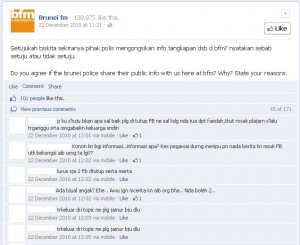
The emphasis was on individual stories on Projek Brunei, which are featured on the website. The format following a question and answer style with pictures and a contextualising comment from Delwin. Simpur Blogging Nation on the other hand, only added a link to their directory placed in a category, with occasional featured websites. Through the network Delwin fostered with BruneiTweet by “following back” and engagement, articles are directly accessed on Projek Brunei. He has described the site as an extension of his Twitter account, BruneiTweet.
Projek Brunei is a bridge between micro-blogging and blogging. Marul, who now describes himself part of a SocMed group, identifies himself more as a micro-blogger. In this regard, Delwin straddles micro-blogging and blogging utilising both Projek Brunei and BruneiTweet to generate content. Brunei fm on the other hand primarily uses Facebook to engage with their audience with their website taking a back seat. Each distinct in how they create content but all focusing on engagement and participation.

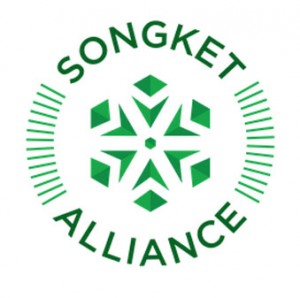
The reasons for blogging have shifted, awareness of the audience and the social role blogging should play are emphasised. Zul-Fadly noted its immense personal quality in 2006, Delwin in 2010 understood there is the potential for not just Bruneians but the world to read, and we find ourselves again with an emphasis on personal narrative with Songket Alliance in 2013. Individual voices which showed the reader how the author viewed the world, shifted to a broader approach of how the world should view Brunei and have now coalesced into a view of showing the rest of Brunei but also the world individual stories from the country.
Viral Content (back to Top)
Viral content is helpful in understanding the relationship between platform websites and content. Seeing how content spreads without platform websites runs counter to the claim that content isn’t appreciated in the country or it’s hard to know what is going on. In the case of videos uploaded to Youtube, ‘Brunei | “Tattered and Brainwashed”‘ or ‘Sikap anak muda brunei yg suka tunjuk gagah‘ they were spread on social media and messaging services, barely showing up on platform websites. However, Ranoadidas (right pic) referred to videos taken during His Majesty’s meet and greet in the capital in September. Only using text and an image to instigate discussion rather the video itself, discussion was only on Instagram and the videos weren’t posted on his website.
People in their droves poured scorn over the videos mentioned and subsequently shared their grievances on social media, primarily in heated group discussions on Whatsapp. In a video posted by RTB (Radio Televisyen Brunei) News Facebook page (left pic) on the new demerit point system, SiKAP (Sistem Keselamatan Amalan Pemandu) implemented by the Ministry of Communication, shares reached triple figures within a day but a handful comments on the publicly available video itself, showing a move towards private expressions of frustration.
Content can spread easily and quickly without platform websites. However, when it comes to spreading content, platform websites claim they aren’t known or given enough attention in print media. As the founder of the website Brunei Entertainment explains, “I created this website to increase awareness on all food and entertainment in Brunei.” Videos such ‘Brunei | “Tattered and Brainwashed”‘ has been viewed many more times than videos showcasing talent in the country. A search on Youtube for Brunei immediately shows the video on the first page of results, while local content requires going into the other pages of results.
The web series by Visual Dimension Productions, (left above) ‘Break’ was posted on Youtube and their own social media presence only later to be posted on platform websites. Akinari (right above) regularly gets thousands of views for his videos through the nearly 5,000 subscriptions to his Youtube channel. In an interview with The Brunei Times for Youth Speak Akinari mentioned that he doesn’t do a lot to promote his content apart from sharing it on his Facebook account, his videos are spread virally.
The directive announced in July this year by the Brunei Islamic Religious Council (MUIB) banning daytime dining in Muslim-owned restaurants, adds another perspective to the role of platform websites. Jay on this blog talked about possible issues surrounding the directive and also addressed a comment on Facebook, he was inundated with responses on his blog.
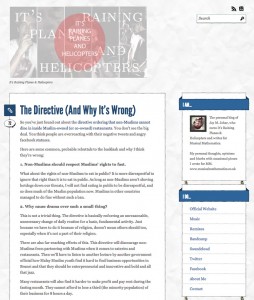
The reach of this post can be compared to that of The Brunei Times Bookmarks, which are compilations of archive material on a subject, usually attracting less than ten comments and a handful of likes. These bookmarks are minimally shared on Facebook and Twitter. The most comments a Bookmark received is 135 for “Chasing after Brunei’s runaway scholars”
Recent events such as the Syariah Court Penal Code ruling which is to be introduced in phases, show the viral potential of content. The post which announced the ruling on the day itself has approximately 1,200 likes on Facebook, eventually reaching 143 comments surpassing the most liked and commented article on The Brunei Times website at that time.
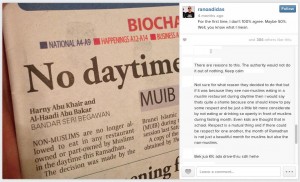
Beyond Platform Websites (back to Top)
What are the relevance of these platform websites which claim to be portals to Brunei? Content whether positive or negative spreads through social media and messaging services regardless of the source. The format in which the content is shared on blogs have not changed from how it was during the initial “Bang” in 2006: a write-up with some images. However, the way content spreads has changed immensely.
Now businesses primarily use platform websites to promote their products. Content on platform websites are crowded out by adverts, offering products from the same few names. The scope of platform websites have narrowed in comparison to the blogs which sprung up earlier in the decade. In 2011, The Wheat helpfully wrote advice for businesses which still applies to this day. He wrote about adverts on Bruneian websites, “I understand the need to make money, but when I see multiple and obtrusive ad spots all over your page, it really turns me off. To me, it conveys that you value the money from your advertisers more than you value my experience (as a customer / viewer) on your site.”
The “Bang” that LSM wrote about was an exciting moment, not just for the blogging community, but for the country to reflect on themselves and know more about each other. Content covered topics which represented the diversity of its inhabitants. The community on Youtube, Soundcloud and Facebook are vibrant without the reliance on platform websites. Platform websites evolved with the blogging community but when it quieted down, content reverted to businesses and their products rather than originality. There are of course few exceptions to this with podcasting and video content.
Podcasting has been taken up by a few, mostly focusing on niche topics such as films or geek culture but most are defunct. These include: Talking Aloud (who has removed his podcasts from iTunes and his website); Corner Geeks hosted by The Wheat and Firdaus Zailani (last podcast was in May 2013); Visual Dimensions Podcast hosted by Adam Groves (last podcast was in October 2012); and most recently Ranoadidas‘ podcast on movies The Popcorn Panel which was updated last week.
While vlogging or daily video updates has yet to be picked up, a handful of Youtubers from Brunei focus on short films, comedy sketches and trailers for events. Click to view a Youtube list of channels from Brunei.


Resources (back to Top)
Brunei, Debating. “Blog Journalism”, 29 March 2008. Date accessed Oct 2013. http://debatingbrunei.blogspot.com/2008/03/blog-journalism.html
Borneo Colours. “Featured Twitterer: BruneiTweet”, 12 November 2010. Date accessed Oct 2013. http://www.borneocolours.com/2011/04/featured-twitterer-emmagoodegg/
Borneo Colours. “Featured Twitterer: BruneiTweet”, 12 November 2010. Date accessed Oct 2013. http://www.borneocolours.com/2010/11/featured-twitterer-bruneitweet/
Daniel, Azhani. “Emma’s Brunei Online 2006”, 8 January 2007. Date accessed Nov 2013. http://emmagoodegg.blogs.com/thebeehive/2007/01/emmas_brunei_on.html
Fenn, Rob. “The Brunei Blogosphere: Kingdom of Unexpected Treasures”, 11 September 2012. Date accessed Nov 2013. http://blogs.fco.gov.uk/robfenn/2012/09/11/the-brunei-blogosphere-kingdom-of-unexpected-treasures/
Hizam, Nasroul. “Best personal blog announced”, 10 October 2007. Date accessed Oct 2013. http://www.bt.com.bn/home_news/2007/10/10/best_personal_blog_announced
IngSiang. “Simpur’s Blogging Nation”, 5 March 2007. Date accessed Oct 2013. http://bruneigeek.blogspot.com/2007/03/simpurs-blogging-nation.html
Ipod Halo Effect, “Hello Blogging Nation!”, 18 April 2007. Date accessed Oct 2013. http://ipodhaloeffect.wordpress.com/2007/04/18/hello-blogging-nation/
Johar, Mujahid. “A Reaction To The Statement By MUIB”, 3 August 2013. Date accessed Oct 2013.http://mujahidjohar.net/post/57199249925/a-reaction-to-the-statement-by-muib
Johar, Mujahid. “I’m A Kanak-Kanak Hingusan”, 28 July 2013. Date accessed Oct 2013.http://mujahidjohar.net/post/56698353953/im-a-kanak-kanak-hingusan
Johar, Mujahid. “No Apathy”, 28 July 2013. Date accessed Oct 2013.http://mujahidjohar.net/post/56687621734/no-apathy
Johar, Mujahid. “On The Directive: Let’s Get Practical”, 31 July 2013. Date accessed Oct 2013.http://mujahidjohar.net/post/56935436768/on-the-directive-lets-get-practical
Johar, Mujahid. “The Directive (And Why It’s Wrong)”, 27 July 2013. Date accessed Oct 2013. http://mujahidjohar.net/post/56593320451/the-directive-and-why-its-wrong
Katie-Ella. “Brunei Bloggers: Don’t give up”, 9 December 2006. Date accessed Oct 2013. http://katie-ella.blogspot.com/2006/12/brunei-bloggers-dont-give-up.html
Maurina. “Have you heard of the Bloggies?”, 13 September 2007. Date accessed Oct 2013. http://maurina.wordpress.com/2007/09/13/have-you-heard-of-the-bloggies/
Maurina. “Let me introduce you to those who came before me”, 29 March 2007. Date accessed Oct 2013. http://maurina.wordpress.com/2007/03/29/let-me-introduce-you-to-those-who-came-before-me/
Maurina. “The first move”, 21 April 2007. Date accessed Oct 2013. http://maurina.wordpress.com/2007/04/21/510/
Possiblyzebra, “LegCo 2012: Thanks for the Update”, 10 March 2012. Date accessed Oct 2013. http://possiblyzebra.net/p/2012/03/legco-2012-progress-update/
Possiblyzebra, “LegCo 2012: Word of the day is “Expectations”, 9 March 2012. Date accessed Oct 2013. http://possiblyzebra.net/p/2012/03/legco-2012-expectations/
Rahman, Jefri. “Bloggers’ Rights & Responsibilities: Discussion on 25 September 2010”, 18 September 2010. Date accessed Nov 2013. http://techlegalese.blogspot.com/2010/09/bloggers-rights-responsibilities.html
Rahman, Jefri. “Bloggers’ Rights and Responsibilities: Discussion on 25th September 2010 “, 27 September 2010. Date accessed Nov 2013. http://techlegalese.blogspot.com/2010/09/bloggers-rights-and-responsibilities.html
Sheng Ming, Lim. “Brunei Bloggers, a retrospective look. Part 1: The Bang”, CNET Asia, Date accessed Oct 2013. http://asia.cnet.com/blogs/brunei-bloggers-a-retrospective-look-part-1-the-bang-62114135.htm
Sheng Ming, Lim. “Brunei Bloggers, a retrospective look. Part 2: The Scare”, CNET Asia, Date accessed Oct 2013. http://asia.cnet.com/blogs/brunei-bloggers-a-retrospective-look-part-2-the-scare-62114136.htm
Sheng Ming, Lim. “Brunei Bloggers, a retrospective look. Part 3: The Ally”, CNET Asia, Date accessed Oct 2013. http://asia.cnet.com/blogs/brunei-bloggers-a-retrospective-look-part-3-the-ally-62114138.htm
Sheng Ming, Lim. “Brunei Bloggers, a retrospective look. Part 4: The Wrap-Up Party”, CNET Asia, Date accessed Oct 2013. http://asia.cnet.com/blogs/brunei-bloggers-a-retrospective-look-part-4-the-wrap-up-party-62114140.htm
Singapore Management University. “Digital Media in Brunei” Date accessed Nov 2013. https://wiki.smu.edu.sg/digitalmediaasia/Digital_Media_in_Brunei
Thanis Lim. “ My story – Food adventures of Thanis Lim”, 22 October 2013. Date accessed Oct 2013.http://www.thanislim.com/2013/10/my-story-food-adventures-of-thanis-lim.html
The Brunei Times. “A prudent foodie”, 21 August 2010. Date accessed Nov 2013. http://www.bt.com.bn/features/2010/08/21/prudent-foodie
The Brunei Times. “Blogging getting popular in Brunei”, 23 November 2008. Date accessed Nov 2013. http://archive.bt.com.bn/home_news/2008/11/23/blogging_getting_popular_in_brunei
The Brunei Times. “Born to be a blogger: Emmagoodegg”, 24 December 2011. Date accessed Oct 2013. http://www.bt.com.bn/features/2011/12/24/born-be-blogger
The Brunei Times. “Rights, social reponsibilities of bloggers”, 26 November 2010. Date accessed Nov 2013. http://www.bt.com.bn/features/2010/09/26/rights-social-reponsibilities-bloggers
The Report: Brunei Darussalam 2011. “Network Upgrades” The Report: Brunei Darussalam 2011, Oxford Business Group 2011. 180. Print.
King, Nonnie. “44 / Serikandi / Mini-bloggers gathering, 27 January 2009. Date accessed Nov 2013. http://kisich.blogspot.com/2009/01/44-serikandi-mini-bloggers-gathering.html
King, Nonnie. “Brunei Newspaper”,18 August 2006. Date accessed Oct 2013. http://kisich.blogspot.com/2006/08/brunei-newspaper.html
Wheat, The. “A Message to Brunei Website Owners – Do you value money or people?”, 13 September 2011. Date accessed Nov 2013. http://blog.thewheatfield.org/2011/09/13/a-message-to-brunei-website-owners-do-you-value-money-or-people/
Wheat, The. “Brunei.fm”, 13 September 2011. Date accessed Nov 2013. http://blog.thewheatfield.org/2009/06/20/brunei-fm/
Wheat, The. “My Message to Businesses in Brunei”, 21 June 2011. Date accessed Nov 2013. http://blog.thewheatfield.org/2011/06/21/my-message-to-businesses-in-brunei/
Zul-Fadly. “Thank You One thousand visitors in One Mont”, 27 August 2006. Date accessed Nov 2013. http://soulkonekshen.blogspot.com/2006/08/thank-you-one-thousand-visitors-in-one.html
Share Your Thoughts (back to Top)
What happened to blogging in Brunei? Why did it slow down?
Do you think platform websites are needed?
What other kinds of online content should we see from Brunei?
Share your thoughts below!
[edited: November 27 11.30am]


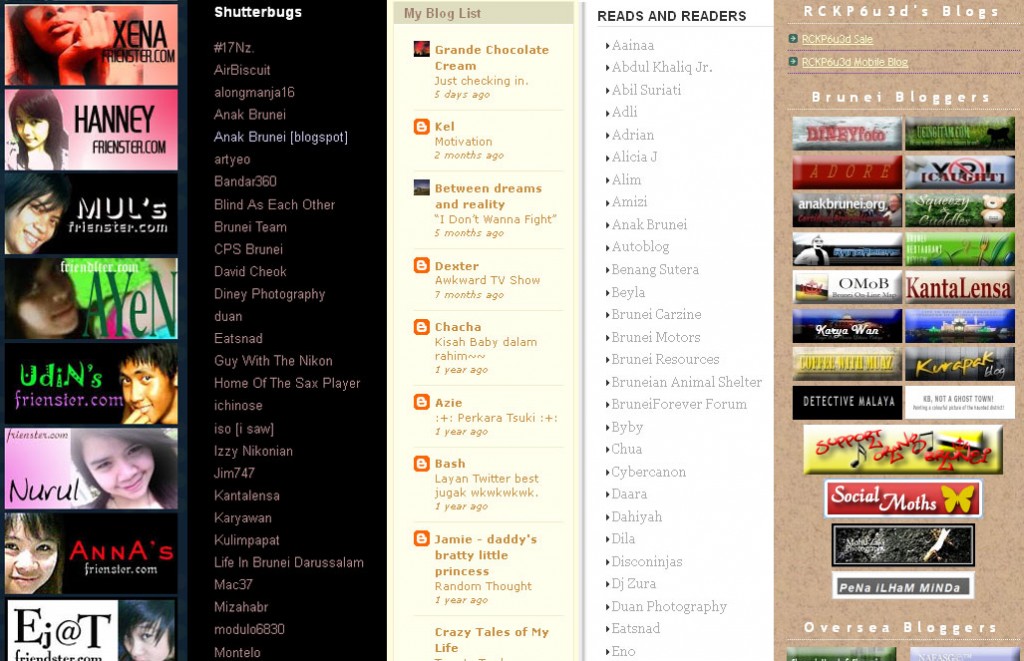
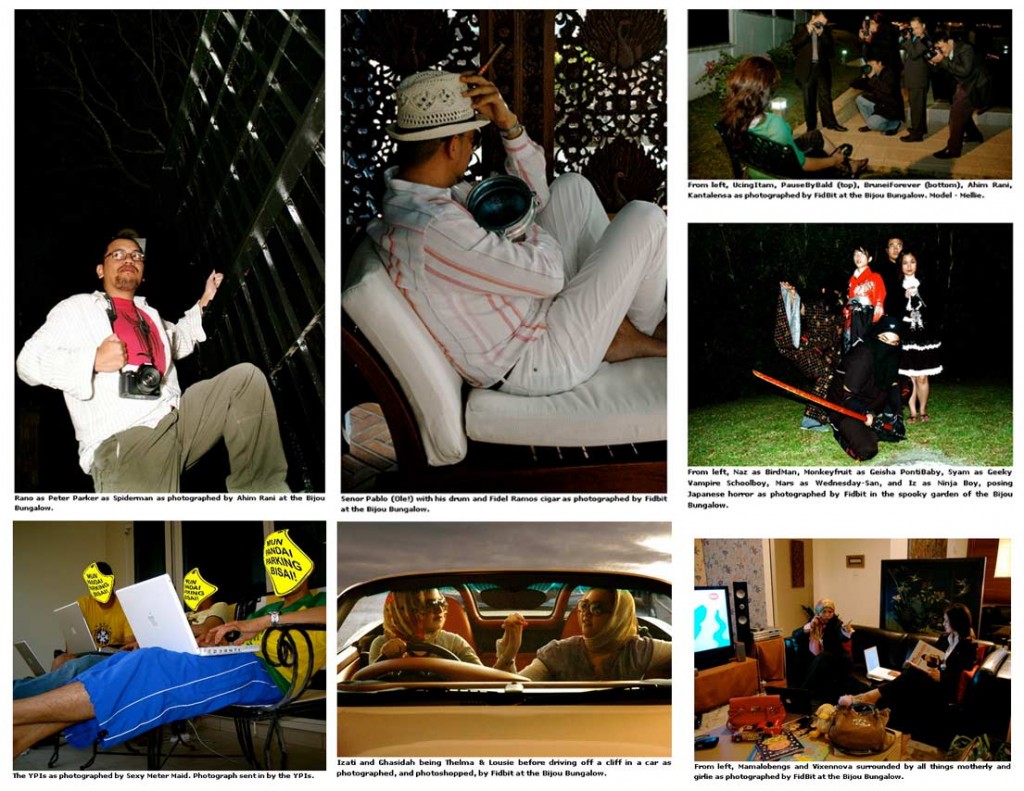



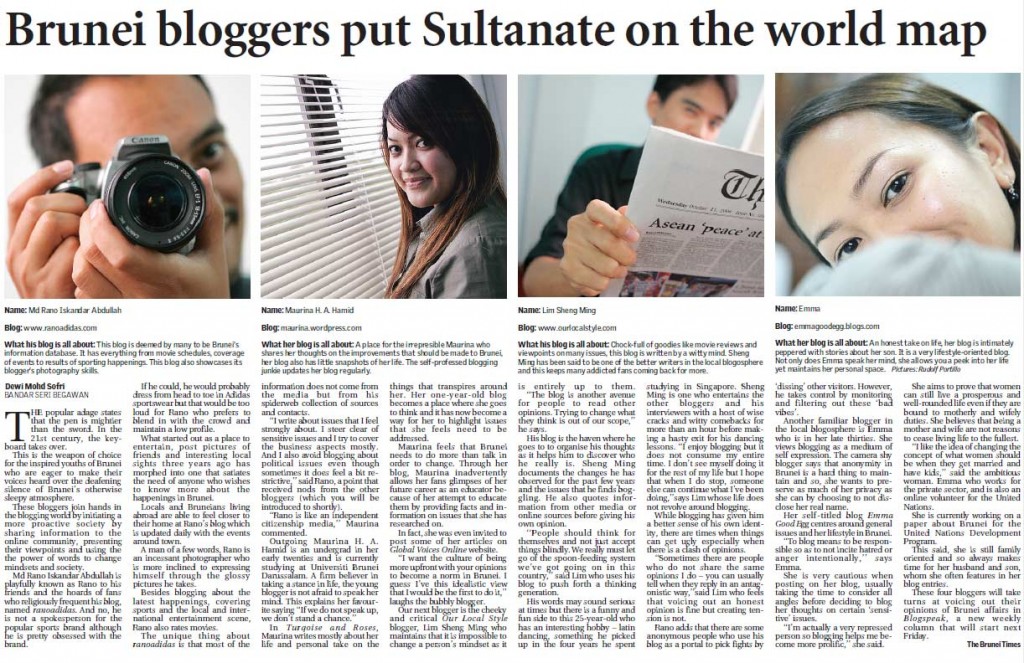

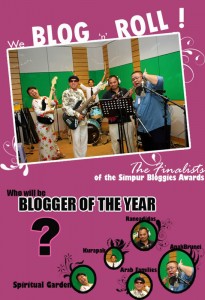
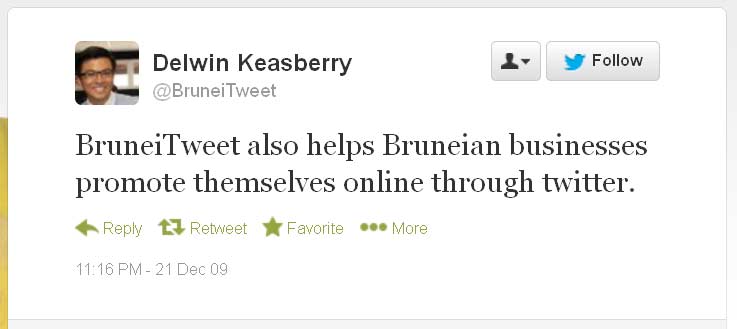
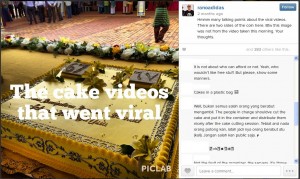
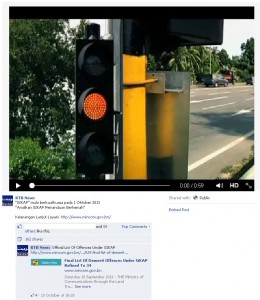
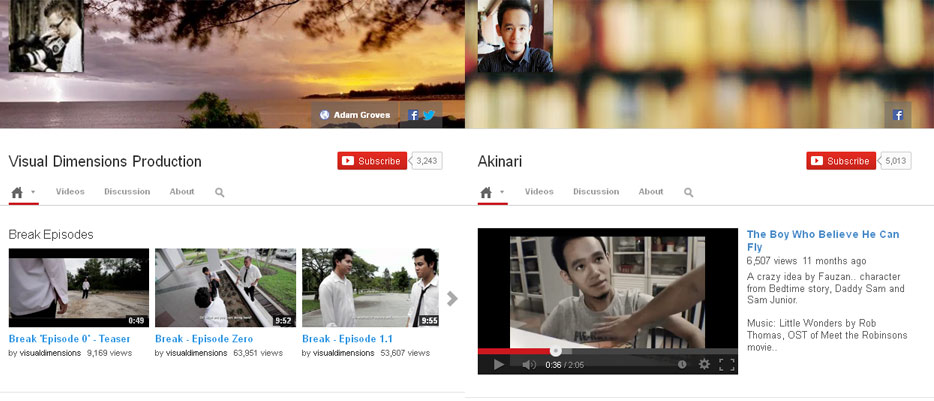
Hi!!!!!! During the blogging boom, I was in my university years so it was my first time to be able to relate thoughts and ideas somewhat so it was so siok!!!!! Anyway, I have moved very much to microblogging now in Instagram – nowadays my blog has too many unpublished drafts (start but never finish a post)! I should aim to finish one at least. U have inspired me!
Hi, I think because you were able to get your thoughts and ideas out there when you were in university, the blog did as well as it did. The move into micro-blogging is great, but sometimes depending on the topic having a bit more room to write and the ability to comment properly is good as well. I am sure you have plenty more things to say!
A good write up about the Brunei online community! Keep up the good work. My main blog is http://www.thanislim.com though. Thank you for sharing this informative writeup! 🙂
Thanks I updated the link.
I do wonder if blogging as personal endeavour is still relevant, especially with the different ways there are today to consume online media.
During the blogging days, smartphones were nowhere near as functional as they are now, and tablets were virtually unheard of; the only way to access the Internet was through a computer, and there was no one platform you could subscribe to to get an aggregated view of all the blogs you follow (exception being using RSS feeds, which was not used widely). People followed specific blogs and stuck with them, and would visit those pages every so often for new content.
Nowadays, places like Tumblr, Twitter and Instagram, where you can follow certain people and get their posts on a personalised home page, as well as their respective apps you can use one your mobile devices, makes it less convenient to follow blogs, which are often scattered all over on different websites and content management systems. These apps also allow people to quickly publish their content and get almost instant feedback. I think this is what most bloggers have realised and which has caused the few who are still active to move off their respective blogging platforms.
What I would like to see is a mesh of information and media from places like Twitter and Instagram, which are “real-time” in the content and discussions they generate, but limited in their character restrictions and time-sensitive (and as you touched on, more difficult to keep track of), expanded into longer narrative with more information and data, which would hopefully also serve as a place to generate more in-depth discussions. It’s a selfish request borne of being unable to follow all these platforms, but I think it is a service which many would welcome.
On another note, I was one of the commenters on Maurina’s post on having a wiki, and we did eventually set up and establish a Brunei Wiki at a point in time, but due to lack of interest and resources it fell into abandon. If anyone is still interested in rebuilding it, let’s talk.
I remember this. Have we talked about archiving these various Brunei-related projects? Yes, I am interested in the projects themselves rather than the Brunei Wiki, though that is a great idea too!
Sent you an e-mail about this!
I share the same sentiment with regards to microblogging and the “instant” ways in which people post and respond to content. I’d love to see a return of those longer blog posts, but am aware of this “shift” in how content is being created and shared, and it’s probably unwise to turn my back on it. I like the idea of integrating microblogging platforms with others that allow expansion of ideas and discussion. It’s probably even already in progress, somewhere out there – but just hasn’t hit mainstream usage yet. (If anyone knows any specific technologies, please do share!)
Micro blogging is more convenient and easier to digest in our fast paced smart phones era. This is not to say that blogs are becoming obsolete as people still want more detailed information especially when it comes to detailed information like choosing which phone or camera to buy, travel tips, make up tutorials and even recipes – blogs and websites still supply the masses and are more effective than microblogging.
That said – the power of combining micro blogging with blogs is very useful. Microblogging keeps your readers has helped me inform the public on the latest food news and food adventures but also links them to my latest blog posts, as well as sharing old posts. Microblogging is more interactive in terms of communicating with your readers and followers – and I do miss the good old times when people would comment and share their thoughts on our blogs – nostalgic!
Hi again, I think your point about commenting is interesting. It seems are though the interactions on micro-blogging is significantly different from blogs. Do you think people spend more time on blogs as opposed to micro-blogging? Spending more time on blogs could mean that comments are more considered, or do you think that micro-blogging is a better way to have conversations?
It’s definitely easier to comment and have a conversation through micro blogging. With blogs – people have to login and await moderation as well. This makes it less interactive – and blog comments are less common nowadays and this is as you say – due to the growth of micro blogging in Facebook and Instagram.
One factor contributing to the ‘fall’ of blogging was the oversaturation of similar content across different blogs. The success of several prominent bloggers inspired imitations trying to emulate their success yet not delivering much in original commentary or content.
The concept of personal blogging has become almost obsolete with the rise of Facebook, with friends being able to updates friends and family with status updates, photo albums, and videos on one single, aggregated feed.
For “oversaturation” as a factor, do you think it affected blog-reading or blog-writing? I feel like the oversaturation would have been something the readers felt, rather than the bloggers. It might have meant that the imitations were redundant and thus less popular to readers, or conversely the reader traffic became spread out across both the more prominent bloggers and the imitators. Then, does either of these contribute to the bloggers’ own decline in blogging activity?
On another point, I read recently about how hashtags has also helped to aggregate content regardless of where they come from. For example using them to hashtag photos under a particular event, like #eventname2013 on Instagram, or, an earlier example but in a similar fashion, putting pictures in a group pool on Flickr for said event. I wonder if this counters the oversaturation and the desire to post your own photos. I’ve certainly noticed, over the years, how I’ve taken less and less photos at events, knowing that someone else will be doing it instead.
Wonderful article. Well done! I never realised that blogging have come a long way till I read this. Thank you!
Blogging and micro-blogging are complimentary mediums. I do not think one detracts from the other. Blogging allows for context / proper framing whereas the latter allows for real-time engagement.
Hmm, I personally think that’s an idealised system of using blogging and microblogging in a complementary way – mohamednazmi touched on it as well in his comment above – but in practice it seems (my perception only) that blogging has declined as people have chosen to participate in microblogging only. What do you think?
Pingback: Criticism and Continuity in Brunei | possible
Pingback: Sharia Law and Free Speech in Brunei · Global Voices
Pingback: Lei Sharia e a Liberdade de Expressão em Brunei · Global Voices em Português
Hi. im from Malaysia and never been to Brunei. Hopefully this year i could make it and explore more about Brunei.
Thanks
Hi I am from Indonesia I looking for blogger from Brunei so I read this article thanks for open my mind about websites in brunei
Pingback: Bruneian Literature in English: An Observation – Open Brunei